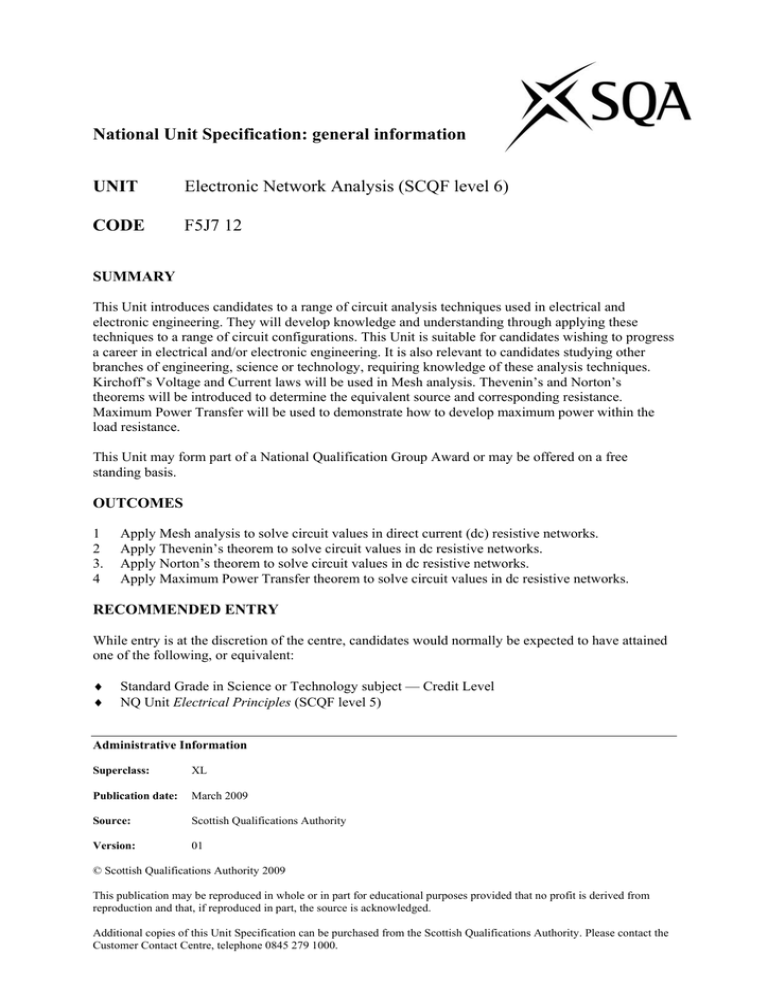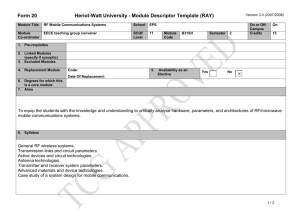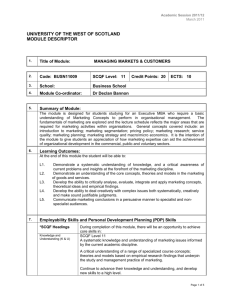national unit specification: general information
advertisement

National Unit Specification: general information UNIT Electronic Network Analysis (SCQF level 6) CODE F5J7 12 SUMMARY This Unit introduces candidates to a range of circuit analysis techniques used in electrical and electronic engineering. They will develop knowledge and understanding through applying these techniques to a range of circuit configurations. This Unit is suitable for candidates wishing to progress a career in electrical and/or electronic engineering. It is also relevant to candidates studying other branches of engineering, science or technology, requiring knowledge of these analysis techniques. Kirchoff’s Voltage and Current laws will be used in Mesh analysis. Thevenin’s and Norton’s theorems will be introduced to determine the equivalent source and corresponding resistance. Maximum Power Transfer will be used to demonstrate how to develop maximum power within the load resistance. This Unit may form part of a National Qualification Group Award or may be offered on a free standing basis. OUTCOMES 1 2 3. 4 Apply Mesh analysis to solve circuit values in direct current (dc) resistive networks. Apply Thevenin’s theorem to solve circuit values in dc resistive networks. Apply Norton’s theorem to solve circuit values in dc resistive networks. Apply Maximum Power Transfer theorem to solve circuit values in dc resistive networks. RECOMMENDED ENTRY While entry is at the discretion of the centre, candidates would normally be expected to have attained one of the following, or equivalent: ♦ ♦ Standard Grade in Science or Technology subject — Credit Level NQ Unit Electrical Principles (SCQF level 5) Administrative Information Superclass: XL Publication date: March 2009 Source: Scottish Qualifications Authority Version: 01 © Scottish Qualifications Authority 2009 This publication may be reproduced in whole or in part for educational purposes provided that no profit is derived from reproduction and that, if reproduced in part, the source is acknowledged. Additional copies of this Unit Specification can be purchased from the Scottish Qualifications Authority. Please contact the Customer Contact Centre, telephone 0845 279 1000. National Unit Specification: general information (cont) UNIT Electronic Network Analysis (SCQF level 6) CREDIT VALUE 1 credit at SCQF level 6 (6 SCQF credit points at SCQF level 6*). *SCQF credit points are used to allocate credit to qualifications in the Scottish Credit and Qualifications Framework (SCQF). Each qualification in the Framework is allocated a number of SCQF credit points at an SCQF level. There are 12 SCQF levels, ranging from Access 1 to Doctorates. CORE SKILLS There is no automatic certification of Core Skills in this Unit. This Unit provides opportunities for candidates to develop aspects of the following Core Skill: ♦ Numeracy (SCQF level 6) These opportunities are highlighted in the Support Notes of this Unit Specification. Unit Specification — Electronic Network Analysis (SCQF level 6) 2 National Unit Specification: statement of standards UNIT Electronic Network Analysis (SCQF level 6) Acceptable performance in this Unit will be the satisfactory achievement of the standards set out in this part of the Unit Specification. All sections of the statement of standards are mandatory and cannot be altered without reference to SQA. OUTCOME 1 Apply Mesh analysis to solve circuit values in dc resistive networks. Performance Criteria (a) (b) (c) (d) Correctly apply Kirchhoff’s current law. Correctly apply Kirchhoff’s voltage law. Correctly derive Mesh simultaneous equations. Correctly determine circuit currents and voltages. OUTCOME 2 Apply Thevenin’s theorem to solve circuit values in dc resistive networks. Performance Criteria (a) Correctly determine the Thevenin resistance. (b) Correctly determine the Thevenin voltage source. (c) Correctly use the Thevenin equivalent circuit to determine load current and voltage. OUTCOME 3 Apply Norton’s theorem to solve circuit values in dc resistive networks. Performance Criteria (a) Correctly determine the Norton resistance. (b) Correctly determine the Norton current source. (c) Correctly use the Norton equivalent circuit to determine load current and voltage. OUTCOME 4 Apply Maximum Power Transfer theorem to solve circuit values in dc resistive networks. Performance Criteria (a) Correctly determine the value of load resistance for maximum power transfer. (b) Correctly determine the maximum power developed. (c) Correctly determine the power developed in a given load resistance different to that providing maximum power transfer. Unit Specification — Electronic Network Analysis (SCQF level 6) 3 National Unit Specification: statement of standards (cont) UNIT Electronic Network Analysis (SCQF level 6) EVIDENCE REQUIREMENTS FOR THIS UNIT Evidence is required to demonstrate that candidates have achieved all Outcomes and Performance Criteria. Written and/or recorded oral evidence is required which demonstrates that the candidate has achieved all Outcomes to the standards specified in the Outcome and Performance Criteria. This evidence should be produced under supervised, controlled conditions at appropriate points throughout the Unit either on an Outcome by Outcome basis or as integrated assessments. All calculations and measurements should be given using the relevant SI units of measurement. The required evidence, for all Outcomes, is as follows: For Outcome 1, the candidate should apply Mesh analysis to a dc resistive network consisting of a mesh circuit containing a minimum of two resistors and one voltage source in each of two meshes. In order to achieve this Outcome, candidates should be able to: ♦ ♦ ♦ ♦ correctly apply Kirchhoff’s current law at junctions correctly apply Kirchhoff’s voltage law within mesh correctly derive mesh simultaneous equations correctly determine all resistor currents and voltages For Outcome 2, the candidate should apply Thevenin’s theorem to a dc resistive series/parallel network consisting of a minimum of four resistances and one dc source. For Outcome 3, the candidate should apply Norton’s theorem to a dc resistive series/parallel network consisting of a minimum of four resistances and one dc source. For Outcome 4, the candidate should apply Maximum Power Transfer theorem to a dc resistive series/parallel network consisting of four resistances and one dc source. The Assessment Support Pack for this Unit provides sample assessment material. Centres wishing to develop their own assessments should refer to the Assessment Support Pack to ensure a comparable standard. Unit Specification — Electronic Network Analysis (SCQF level 6) 4 National Unit Specification: support notes UNIT Electronic Network Analysis (SCQF level 6) This part of the Unit Specification is offered as guidance. The support notes are not mandatory. While the exact time allocated to this Unit is at the discretion of the centre, the notional design length is 40 hours. GUIDANCE ON THE CONTENT AND CONTEXT FOR THIS UNIT This is a restricted core Unit within the National Certificate in Electronic Engineering at SCQF level 6 and an optional Unit within the National Certificate in Electrical Engineering at SCQF level 6. It may also form part of other National Qualification Group Awards in engineering. This Unit may also be delivered as a free standing Unit. The theory should be delivered in the context of electrical and/or electronic problems depending upon the candidates course of study. Wherever possible the context should be as realistic as possible in order to demonstrate the application of the theory to real electrical and electronic engineering problems. GUIDANCE ON LEARNING AND TEACHING APPROACHES FOR THIS UNIT The Unit can be delivered in a classroom environment. The Unit is theoretically based and as such, learning approaches should include the use of worked examples to reinforce the application of the techniques and theorems used. In Outcome 1, the use of Kirchoff’s voltage and current laws should be used and the importance of labelling voltages and currents should be emphasised to minimise errors. In Outcomes 2 and 3, the advantage in using the theorems should be emphasised in terms of ease of determining resistance (load) voltage and current when the load changes. In Outcome 4 the candidates should be made aware of the importance of enabling maximum power transfer to take place. As the Unit is theory based, candidates would benefit through the use of computer simulation software to support teaching and reinforce learning. OPPORTUNITIES FOR CORE SKILL DEVELOPMENT Components of the Core Skill Numeracy will be developed throughout this Unit. Candidates have to interpret and demonstrate understanding of complex numerical and graphic concepts in situations where the relevance and significance of information needs to be translated and applied. The ability to use a range of circuit analysis techniques to solve circuit values will be enhanced by formative opportunities to analyse and apply information in practical electronic engineering contexts. Unit Specification — Electronic Network Analysis (SCQF level 6) 5 National Unit Specification: support notes UNIT Electronic Network Analysis (SCQF level 6) GUIDANCE ON APPROACHES TO ASSESSMENT FOR THIS UNIT Opportunities for the use of e-assessment E-assessment may be appropriate for some assessments in this Unit. By e-assessment we mean assessment which is supported by information and communications technology (ICT), such as e-testing or the use of e-portfolios or e-checklists. Centres which wish to use e-assessment must ensure that the national standard is applied to all candidate evidence and that conditions of assessment as specified in the Evidence Requirements are met, regardless of the mode of gathering evidence. Further advice is available in SQA Guidelines on Online Assessment for Further Education (AA1641, March 2003), SQA Guidelines on e-assessment for Schools (BD2625, June 2005). All Outcomes require written and/or oral evidence. Assessment should be carried out in controlled and supervised conditions. All Outcome assessments will require the candidate to analyse a given circuit corresponding to the stated Evidence Requirements. Outcomes may be integrated at the discretion of the Centre. Outcomes 2 and 3 may provide the most appropriate opportunity for integration. If Outcomes are assessed on an individual basis, suggested assessment times would be thirty minutes per Outcome. Where there is an element of assessment integration, assessment times should reflect this. Each assessment should consist of suitably constructed restricted response questions. DISABLED CANDIDATES AND/OR THOSE WITH ADDITIONAL SUPPORT NEEDS The additional support needs of individual candidates should be taken into account when planning learning experiences, selecting assessment instruments, or considering whether any reasonable adjustments may be required. Further advice can be found on our website www.sqa.org.uk/assessmentarrangements Unit Specification — Electronic Network Analysis (SCQF level 6) 6


